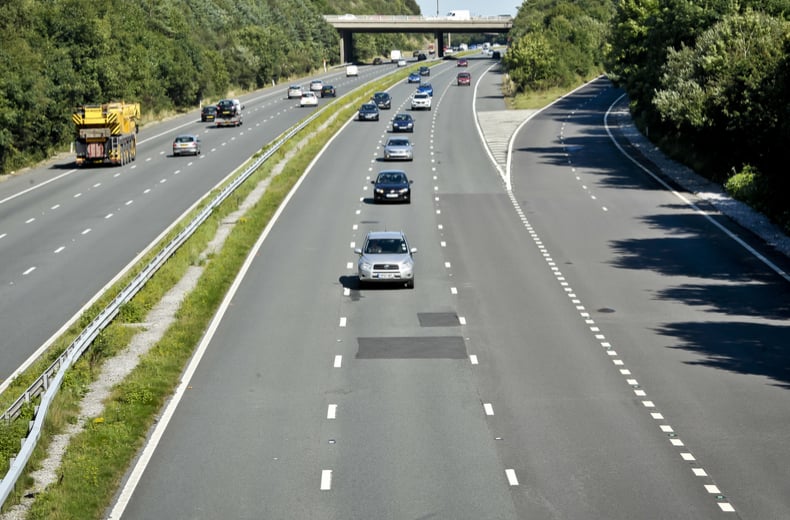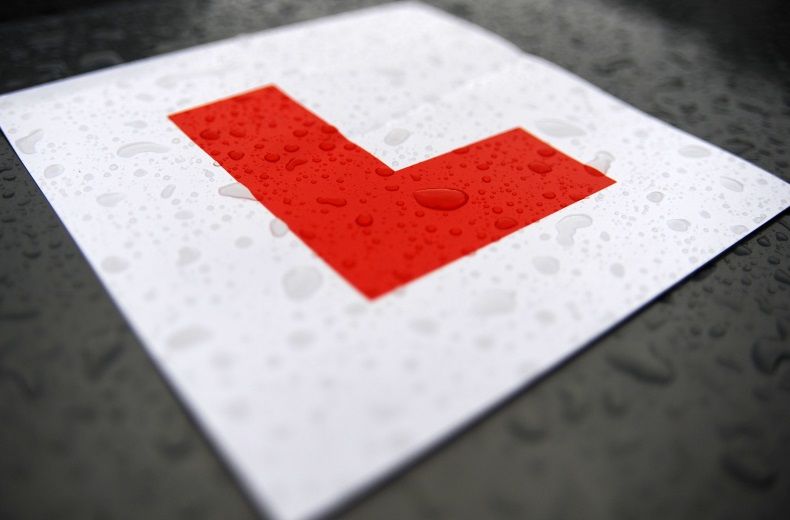There are some things your instructor just doesn’t teach you – whether it’s how to be a courteous driver or how to avoid inadvertently breaking the law.
To help you out, here’s our round up of 17 things every motorist might not know, but should, especially if you’re learning to drive or are a new driver.
1. How to deal with “queue-jumpers” as lanes merge
Some motorists have been left annoyed and confused by the sight of drivers passing them on the right-hand lane only to then zip-merge at the last minute.
But according to the law, those so-called “queue-jumpers” are in the right, with zip-merging used more commonly than you might think to help ease congestion at traffic pinch points.
In the event of two lanes merging, motorists are supposed to use both lanes up until the point of lane closure, at which point they are supposed to take it in turns to merge into one lane, just like a zipper.
Drivers merging ahead of time are actually causing further tailbacks by choosing to merge as soon as possible.
2. How to clear ice from your windscreen
If you’re running late and have to de-ice your windscreen before setting off, you might be tempted to save time by only clearing just enough glass to see out of, a practice called “portholing”.
But don’t, because you could get fined £60 if your vehicle’s deemed to be in a “dangerous condition,” and may even face three penalty points.
Simply removing the ice from the driver’s side of the windscreen is not enough – you must de-ice the entire area, using the wipers when the ice has melted.
The driver must by law have a full view of the road and traffic ahead of the motor vehicle, so it is well worth taking the extra time to fully clear your windscreen and your mirrors too.
3. Paying with your phone at a drive-thru
It might not be the healthiest option but hitting the local drive-thru is a great way of grabbing a quick bite to eat behind the wheel — just make sure you don’t take away a hefty fine while doing so.
If you pay with your smartphone at the till you’ll technically be in breach of the laws surrounding using your hand-held devices while driving, which means you could be served up an automatic £200 fine and six penalty points.
If your engine is running, your phone should be nowhere near your hands. This is still the case if the engine stops automatically to save fuel (called ‘start-stop’ technology).
- 11 of the most annoying driver habits
- Did you know that we offer specialist learner driver insurance?
- Mobile phone driving laws — your questions answered
Learner Driver Car Insurance
Only pay for the cover you need until you’ve passed your test. Get learner driver insurance so you can practice outside of your lessons.


4. How to use your horn properly
In some countries the streets are alive with the sound of constant horn honking but in the UK, we are a little more reserved when it comes to tooting. It should only be used to alert other road users of your presence and other road dangers.
Overly aggressive use of your horn can be considered hostile and could cause other road users to become agitated so it’s best to only use it when you really need to — and don’t forget the Highway Code dictates that you’re not allowed to use your horn between 23:30 and 07:00.
5. How to use full beam headlights
Full beam headlights can be great if you spend a lot of time driving at night on rural roads with little or no street lighting — but to stay safe on the road it’s imperative you use them correctly.
You should switch back to dipped beams as soon as you encounter another vehicle on the road ahead of you so you don’t dazzle them. It’s more than just being courteous as well, being blinded by your full beam headlights could cause them to lose control of their vehicle.
6. Switching the mode of your rear-view mirror
Ever wondered what that switch on the bottom of your rear-view mirror is? Well, it’s actually a handy feature that switches your rear-view mirror from “day mode” to “night mode”.
Switching from day to night can help you deal with the challenges of driving in the dark as the reflection becomes dimmer, meaning you can better cope with the glare from headlights behind you.
7. How to check tyre pressure

A lot of motorists don’t check their tyre pressure from one MOT to the next. Remember that a tyre can actually be under inflated without looking flat to the eye.
Not only will poorly maintained tyres reduce your vehicle's performance, it’ll also see you pay out more in fuel costs and potentially even lead to a blow-out which could cause a collision.
If you’re checking tyre pressure, make sure you do so when the tyres are cold, i.e. before you set off on your journey. This will mean you get the most accurate readings, as warm, recently driven-on tyres could give a false reading.
8. What 'Rubbernecking' is and why you shouldn't do it
Not only is gawping at the scene of a crash insensitive to the victims involved, it can also quickly lead to a build-up of traffic behind you as you slow down to take a look.
If you’re caught taking photos or filming the scene of a collision, you could also be prosecuted by the police, leaving you facing hefty fines, having your phone seized and even hit with a driving ban.
9. Staying hydrated

If you’re heading off on a long journey, one of the most important things to pack in your car is a bottle of water. As well as quenching any thirst, having a drink in the car is the best way to ensure you don’t get dehydrated behind the wheel.
This should be common sense, but aside from getting a dry mouth and a headache, forgetting water ahead of a long drive can have shockingly dangerous repercussions.
Research has shown that driving dehydrated has the same effect on driving ability as a couple of glasses of wine, and leaves motorists feeling drowsy, dizzy, and slower to react.
- 13 driving myths uncovered
- Staying hydrated before driving – what you need to know
- Level crossings – everything you need to know
10. Splashing pedestrians
If you’ve ever been splashed by a passing car speeding through puddles you’ll appreciate just how annoying it is to be left on the roadside soaked to the skin.
Well now you can take comfort in the knowledge that offending motorists can actually be prosecuted for drenching people on the pavement.
Splashing pedestrians is deemed to be driving “without reasonable consideration for other persons” under the Road Traffic Act 1998 and offenders will likely be hit by a £100 fixed penalty notice and three points if they’re caught by police.
11. How to navigate box junctions
Yellow hatched box junctions are important for keeping traffic flowing and anyone caught breaking box junction rules faces fines.
As the Highway Code states, you’re not allowed to stop in a box junction unless you’re turning right and waiting for oncoming traffic to pass, which means you shouldn’t enter the box unless your exit is clear. If you do, you could be fined.
It’s not usually a good idea to try and guess whether or not the vehicle ahead will leave enough space for you to pass over the box junction fully, especially since you can’t always see far enough ahead to be sure.
It’s good practice to only move off when you can see that there is already enough road exposed on the other side of the junction for your vehicle.
READ MORE: Fixed Penalty Notices: all you need to know
12. Playing loud music
Listening to your favourite ABBA hits at blaring volumes might sound like a good idea at the time, but not only is it poor form, it could also be dangerous if it stops any road users from hearing approaching cars or emergency vehicles.
If a police officer deems you to be distracted by your music, you could also be charged with driving without due care and attention.
Wearing headphones isn’t an advisable solution, either. Whilst it isn’t specifically illegal to wear headphones behind the wheel, they could stop you from hearing emergency vehicle sirens, level crossing warnings, other road users and pedestrians approaching your vehicle.
13. Hogging the middle lane

It might seem like just an annoying driving habit, but drivers hogging the middle lane on the motorway are actually in breach of the Highway Code and, since new laws were introduced in 2013, face a fine and penalty points if caught.
Middle lane hogging is classified as a careless driving offence as it makes overtaking on the motorway harder and can see cars dangerously funnelled into the outside lane (lane 3) to pass.
14. How to pass other cars on busy streets
We’ve all been there. You’re driving down a road with a lot of parked cars on either side of the road and another car is coming towards you, which means you have to start assessing where you can safely pull in as neither of you has right of way.
Unfortunately, there isn’t a rule about this and best practice depends largely on the road in question and where the passing places are. However, if you’re driving on a gradient then the right of way should always go to the motorist driving uphill, as it’s harder to pull away safely when driving up an incline.
READ MORE: Parking guide: where you can and can’t park
15. Pouring boiling water onto your windscreen
It might seem tempting on a winter’s morning to fill the kettle and clear away all that pesky windscreen ice in an instant with some boiling water, but don’t even think about it.
The extreme change of temperature (from freezing to boiling) can crack or shatter the windscreen, leaving your vehicle unsafe to drive and you with a hefty bill to replace it.
16. Letting other cars into traffic
There’s no law about whether you should let another motorist enter the flow of traffic or not — it’s simply a question of politeness.
Some drivers actively block motorists from pulling out in front of them but in reality, letting one car in isn’t going to affect your journey. And if every driver lets one car in at busy junctions, the whole road network will move a lot easier.
As with many of the tips in this article, following best practice here will also reduce the potential for road rage, which in turn, will make the road a safer and happier place for all road users.
17. Using the air-con in winter
On hot summer days air-con can feel like a lifesaver, but it can also come in handy during the winter, too.
On cold days, condensation can appear but if you turn on the A/C it will act like a dehumidifier and quickly clear your windows.
Using your air-con during the winter can also be good for the unit itself, as it keeps the oil in the system moving and the important air conditioning components inside well-lubricated.
If none of these tips were news to you then congratulations! You’re a great driver with bags of common sense and you were taught by an amazing driving instructor.
Leave us a comment if there are any other bits of driving advice that you wish your instructor had taught you when you were learning to drive.
Black Box Insurance
Want to pay less for your car insurance? Whether you’re a new driver or just looking to reduce costs, we can help.
































